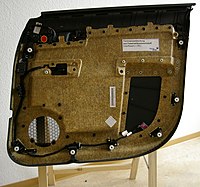
Photo from wikipedia
In this work, we report a facile preparation of biocomposites using a chitosan matrix that is reinforced with morphed graphene in amounts from 1 to 5 wt % C. The… Click to show full abstract
In this work, we report a facile preparation of biocomposites using a chitosan matrix that is reinforced with morphed graphene in amounts from 1 to 5 wt % C. The composites are processed by milling and conventional sintering. The morphed graphene additions show clear improvements in mechanical properties, having a direct correlation with temperature in particular for 180 °C. Higher temperatures are detrimental to chitosan and the properties drop because chitosan degrades. Mechanical properties in the composite such as yield strength and compressive strength increase between 40 and 50% with respect to the pure chitosan samples. The Young's modulus presents a drop of approximately 10%, but the fracture toughness increases up to 3.5 fold. The properties of our sustainable composites are comparable to those seen in polymers such as polyethylene, polypropylene, nylon, and poly(methyl methacrylate), among other commodity or single use plastics. The enhancement in the mechanical properties is attributed to the morphed graphene embedded chitosan matrix that generates a network of intergranular "anchors" that hold the chitosan crystals in place, preventing failure. The composites can be molded into near-net-shape products, machined, or shaped using various methods including laser lithography. These studies demonstrate the feasibility of fabricating biocomposites with different architectures and sizes for disposable structural components. Both chitosan and the composites are compostable and biodegradable with the potential to sustain plant growth when discarded. In addition, morphed graphene and chitosan are produced from byproducts or waste, which may result in a negative carbon footprint on the environment.
Journal Title: ACS applied materials & interfaces
Year Published: 2022
Link to full text (if available)
Share on Social Media: Sign Up to like & get
recommendations!